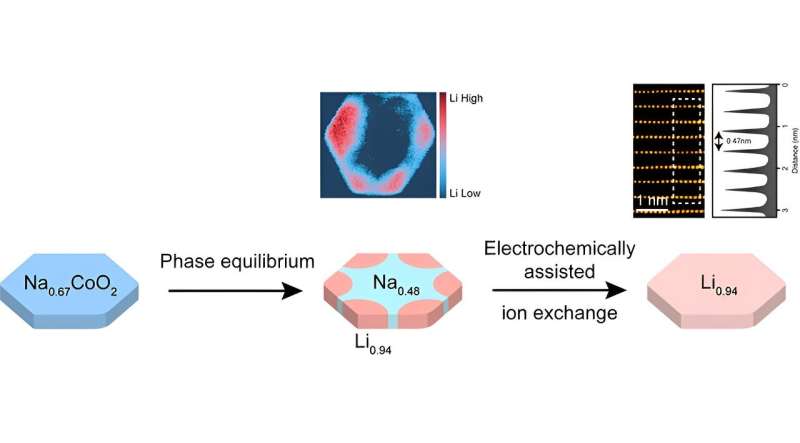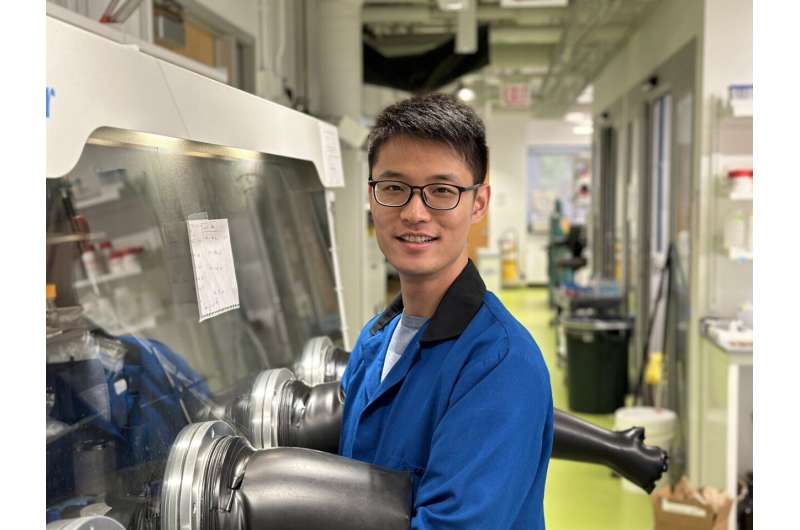This article has been reviewed according to Science X's editorial process and policies. Editors have highlighted the following attributes while ensuring the content's credibility:
fact-checked
peer-reviewed publication
trusted source
proofread
New research could enable more—and more efficient—synthesis of metastable materials

Ion exchange is a powerful technique for converting one material to another when synthesizing new products. In this process, scientists know what reactants lead to what products, but how the process works—the exact pathway of how one material can be converted to another—has remained elusive.
In a paper published in Nature Materials, a team of UChicago Pritzker School of Molecular Engineering researchers shed new light on this mystery. In researching lithium cathode materials for battery storage, a team from the Liu Lab has shown that there is a general pathway for lithium and sodium ion exchange in layered oxide cathode materials.
"We systematically explored the ion exchange process in lithium and sodium," said first author Yu Han, a Ph.D. candidate at PME. "The ion exchange pathway we revealed is new."
By helping explain how the ion exchange process works, this paper opens the doors for researchers working with metastable materials, meaning materials that aren't currently in their most stable possible forms. It can also lead to new innovations in atom-efficient manufacturing, using less of the starting precursors and generating less waste when synthesizing materials.
"It will broaden the family of metastable materials people can synthesize," said PME Asst. Prof. Chong Liu.
New methods
Although the potential applications resonate throughout material synthesis, the paper started by looking at production of lithium for battery cathodes. As climate change pushes the world away from fossil fuels, more and better batteries are needed to store renewable power.
"The old method of solid-state synthesis would be you pick some salt which contains the elements you are looking to synthesize. Then you combine them with the right ratio of each of the element," Liu said. "Then you burn it."

Burning the lithium precursors at 800–900 degrees Celsius is more effective when working with stable materials, however. In cases when the metastable form had interesting properties that could theoretically make great battery cathodes, the high temperatures pushed the materials into a new state that was more stable, but often lacking the interesting properties.
Ion exchange, however, is a synthesis method that can be done at room temperature or at relatively low temperatures of 100 degrees Celsius.
"Room temperature ion exchange allows us to access those metastable layered oxides, which could not be directly synthesized through solid-state synthesis at elevated temperature but might equipped with unique chemical and physical properties," Han said.
In ion exchange, the salts aren't burned but dissolved, letting ions that have the same charge replace unwanted ions. It allows researchers to vary chemical composition while maintaining a solid framework—only the ions are being swapped out. But this too had its drawbacks. The process has historically been resource-intensive and is based on trial and error.
The insights from the PME team's paper will enable researchers to predict not only the final compositions and phases, but also the intermediate states to map out the kinetic pathways.
The PME researchers have already turned their insights on the ion exchange pathways into practice, creating what Han called "a very efficient way" to synthesize lithium (Li) from sodium (Na) and back again. The paper demonstrates the synthesis of pure phase sodium cobalt oxide from the parent lithium cobalt oxide for the first time and also lithium cobalt oxide from sodium cobalt oxide at 1-1000 Li-Na (molar ratio) with electrochemical assisted ion exchange method by mitigating the kinetic barriers.
The team hopes future innovators will go further, creating more efficient, less wasteful processes for synthesizing materials humanity needs for climate change or other pressing global needs.
"In manufacturing now, people are emphasizing atomic efficiency, which means to use the least amount of material to get to what you want," Liu said.
More information: Yu Han et al, Uncovering the predictive pathways of lithium and sodium interchange in layered oxides, Nature Materials (2024). DOI: 10.1038/s41563-024-01862-8
Journal information: Nature Materials
Provided by University of Chicago





















